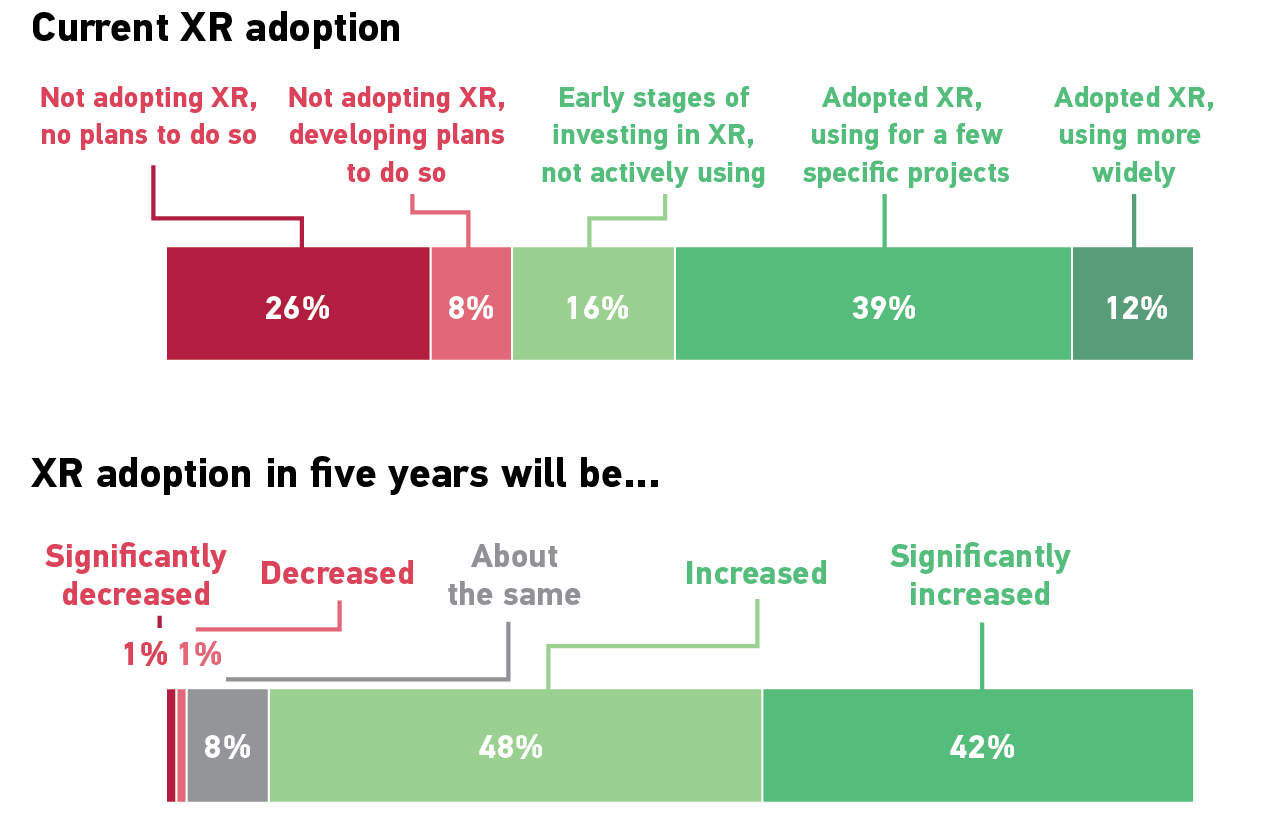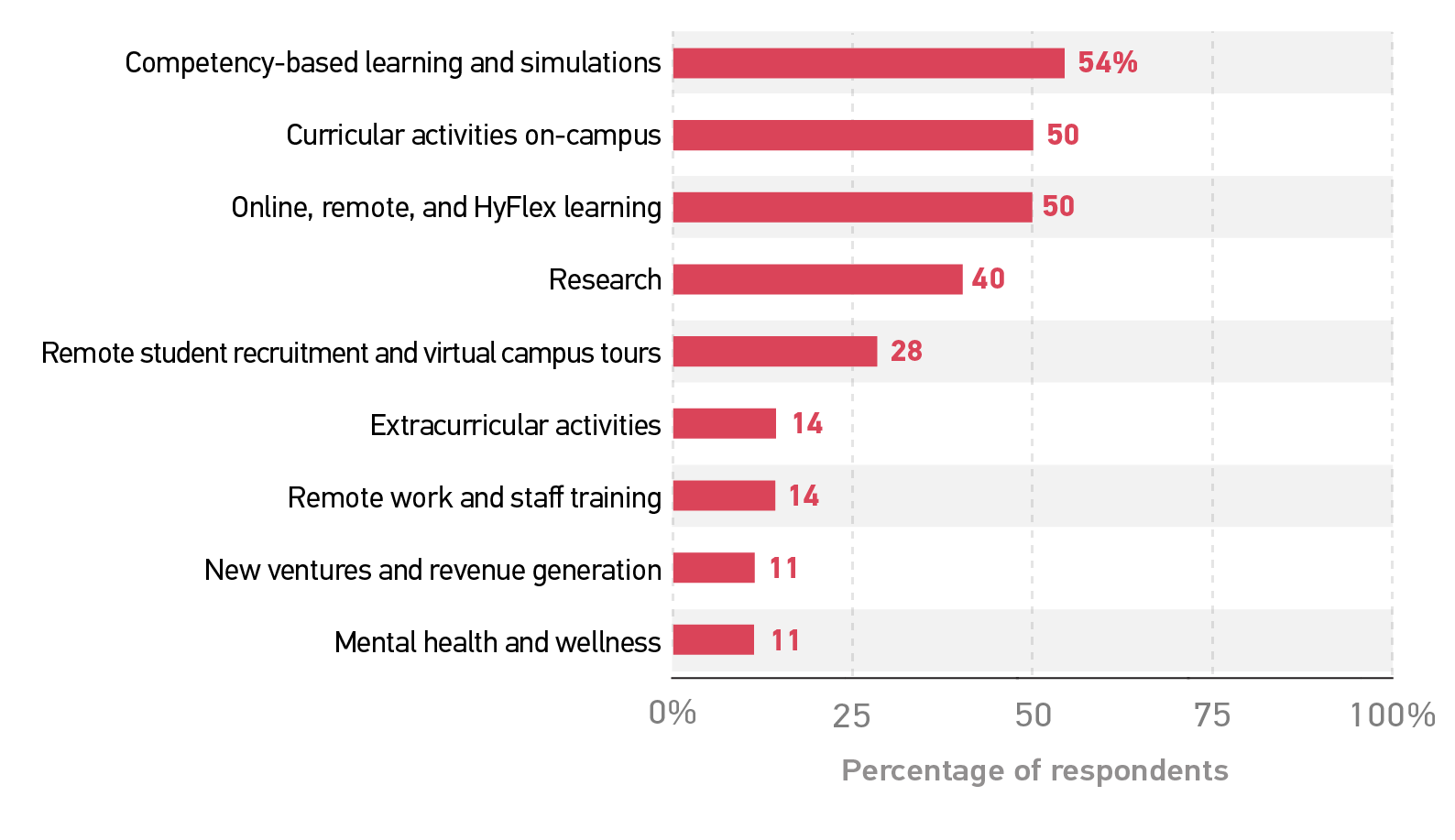Extended reality (XR) adoption in higher education is expected to increase, both as a strategic priority for institutions and as a response to broader market growth for these technologies. Alignment to institutional missions and partnerships with faculty will be key for successful XR implementation.

EDUCAUSE is helping institutional leaders, IT professionals, and other staff address their pressing challenges by gathering and sharing data. This report is based on an EDUCAUSE QuickPoll. QuickPolls enable us to rapidly gather, analyze, and share input from our community about specific emerging topics.Footnote1
The Challenge
This Black Friday season, Amazon offered shoppers an eyebrow-raising deal on the Oculus Quest 2 Virtual Reality headset—the "low" price of $299.Footnote2 Fleeting though this deal may have been, it signals larger trends emerging across the technology landscape: consumers now have easier access to better XR technologies than ever before, and XR equipment and content sales are growing steadily.Footnote3 Whether and how higher education latches onto these trends may yet be unclear. What, if any, are the best institutional uses of XR technologies? What challenges lie ahead for those institutions committed to investing in these technologies? This QuickPoll addresses these and other questions around XR technology in higher education.Footnote4
The Bottom Line
XR technologies are not yet a ubiquitous feature of higher education, and for many institutions they may still be a "nice to have" add-on to traditional modes of teaching and working. And yet growth for XR in higher education is looming on the horizon, as these technologies become more affordable, more available, and more common in our shared social and cultural experiences. As use cases for XR in higher education become more evident, there will be expanded opportunities for institutions to align XR capabilities with their strategic priorities and a greater need for resource investments and faculty buy-in for supporting that alignment.
The Data: Current and Future Adoption of XR
XR technology has arrived...sort of. Many institutions are adopting XR technologies, though mostly for isolated purposes or, as one respondent observed, for "niche programming." The plurality of our survey respondents (39%) reported that their institution has adopted XR technology only for a few specific projects (see figure 1). Twelve percent reported more widespread adoption of XR across multiple departments and for varied purposes, adding up to a majority of respondents reporting at least some level of XR adoption at their institution. When asked about the role of the COVID-19 pandemic in driving institutional XR adoption, 40% of respondents said XR adoption at their institution has increased as a result of the pandemic, indicating that much of the current exploration and use of XR in higher education may be pandemic related.Footnote5

XR adoption will grow, whether we want it to or not. An overwhelming majority of respondents (90%) anticipate that adoption of XR technologies at their institution will somewhat or significantly increase over the next five years. This is the clear sentiment, both among respondents at institutions currently adopting XR and among respondents at institutions with no plans to adopt XR, hinting at a mixture of passive and active shifts in XR adoption in the years ahead.
For some institutions, engagement with XR will occur passively as markets and demand continue to grow and these technologies become a more common feature of our shared social and cultural experiences. Growing numbers of households will own VR headsets. Gaming and entertainment industries will build more of their offerings around XR recreational and educational experiences. And students will increasingly arrive at college with expectations for access to these technologies.
- "We have no plans to implement any XR technologies at the moment, but their evolution into our environment seems inevitable to some degree, so I must predict that our use will slightly increase."
- "I just expect the use of these emerging technologies to increase as the technology becomes ubiquitous across our society."
For other institutions, engagement with XR will be more planned and strategic, less a response to larger shifts and more a result of intentional actions and investments many of them are already making. Committees and working groups are being formed to develop plans for XR adoption. Conversations about the hybrid future of higher education include considerations of their XR capabilities. XR adoption for these institutions will be less reactive and more a strategic necessity for the future.
- "We have an initiative under way now to build an XR strategy with cross-campus involvement, including technology and use cases."
- "[XR] is in our university strategic plan."
The Data: Areas of Future Growth
XR adoption will be mission driven. Digital transformation efforts must be aligned with the institutional mission in order to take hold and result in meaningful change.Footnote6 With XR technologies, too, use cases most aligned with the institutional mission appear to be the primary focus for future investments. Applications of XR technology most relevant to learning—competency-based learning and simulations, curricular activities, and online/remote/HyFlex learning—were far and away respondents' top areas of focus for future XR adoption (see figure 2). Research was also a commonly selected and mission-aligned focus area for future adoption, particularly among doctoral institutions (with 60% of respondents from doctoral institutions selecting it as a priority).

Ancillary uses for XR may not take hold in higher education…yet. For those use cases further outside the core institutional mission—extracurricular activities, remote work and staff training, new business ventures and revenue generation, and mental health and wellness—respondents were less likely to expect increased XR adoption. At some institutions, these applications of XR may feel less strategically necessary and outside their core missional priorities. For other institutions, XR adoption may unfold in stages, with initial investments in strategically important use cases opening up possibilities further down the road for more ancillary use cases.
- "The key focus may initially be on student-oriented applications related to teaching and learning as we develop capacity for use of the technology in other areas."
- "Our institution is predominantly interested in exploratory research and the local and distance implications of XR classroom activities. However, other options on this list are also on the radar."
The Data: Resources and Supports for Success
Faculty and staff are key partners in XR adoption. On a long list of resources and supports that could enable XR adoption in the future, buy-in and support from faculty and staff was by far the most frequently selected support (see figure 3). Funding/budget supports and XR content resources were tied in a distant second place, and strategic vision or goals for XR technology came in a close third.

Importantly, the resources and supports on this list may not be discrete, as some may overlap, be interdependent, or unfold sequentially. Several respondents noted, for example, the importance of XR content in subsequently securing faculty buy-in. As one respondent commented, "We have had some equipment and expertise for use for a number of years now but have struggled with faculty buy-in because of a lack of quality content. We don't have the resources to build substantial content yet." This suggests the need for institutions not only to prioritize their most needed resources and supports but also to think about the procurement of those resources and supports in a more coordinated and cohesive fashion.
Resources and supports are not "one size fits all." Reading down the list of resources and supports no doubt prompts questions about which types of institutions might benefit more or less from each item. Respondents from doctoral institutions, for example, are significantly more likely to prioritize research as a focus area for future XR investments. It is perhaps unsurprising, then, that those respondents are also significantly more likely to prioritize physical space/facilities as an important resource for the future development of institutional XR capabilities. The XR strategy at each institution will be uniquely its own, in other words, and will need to be fitted to its own mission, goals, and needs.
Common Challenges
- XR may be relegated to one person or department. Emerging technologies will have their early adopters and passionate advocates who may at times need to pull their institution along. But when those technologies remain isolated and overly dependent on those passionate few, they run the risk of failing to reach institution-wide adoption and meaningful impact.
"For [XR] proponents, the strategy is clear. However, figuring out where, how, and who on campus can help generate momentum, spread innovation, and provide continually updated/upgraded expertise is the cultural challenge to us all."
- XR demands time and resources that many institutions are unable to invest. Though hardly a groundbreaking discovery, the simple and stubborn truth is that XR costs money and demands investments in staffing and infrastructure. Given that many institutions are facing budget cuts and staffing constraints, substantial near-term investments in new technologies might be unthinkable at some colleges and universities.
"[XR] has tremendous potential in certain well-defined areas, but cost and implementation challenges will preclude significant use."
- For some stakeholders, the jury is still out on the value of XR. Higher education has been fooled by the inflated promise of new technologies before. In the eyes of some key stakeholders at the institution, XR may walk and talk like one of those overhyped technologies, which diminishes those stakeholders' openness to exploring adoption.
"I think my institution would see [XR] as a gimmick and not for educational purposes."
Promising Practices
- XR works best as part of a collaborative, institution-wide strategy. In situations where XR could become relegated to one person or team, efforts to broaden strategic conversations to include other stakeholders across the institution may go a long way toward gaining wider interest and adoption and will help strengthen the strategic influence of IT and technology on campus.
Solution: The Leading Change Institute offers higher education IT and technology leaders the opportunity to hone their skills in building bridges and advocating for and leading change at their institutions.
- Networks of institutions working together can accomplish more than individual institutions can alone. XR may be costly and resource intensive for individual institutions, but some efficiencies can be realized through cross-institution sharing of knowledge and resources. XR content developed at one institution, for example, can be shared with other institutions struggling to know where or how to start with their own content development.
Solution: EDUCAUSE offers a number of opportunities for making peer connections and engaging in peer-based sharing, including the XR Community Group on EDUCAUSE's new Connect platform and XR Learning Lab opportunities.
- XR should and can serve institutional mission and goals. Key institutional stakeholders won't buy into the value of XR if it isn't aligned with and offered in service to core institutional mission and goals. As with most technology adoptions, conversations that begin at the point of stakeholder needs and interests, rather than at the point of the technology itself, have a greater chance of grabbing and holding stakeholder interest and support.
Solution: Though focused on data analytics, the framework for "decision-support maturity" at Drake University may offer XR practitioners helpful ideas for taking a needs-based approach to key stakeholder conversations.Footnote7
All QuickPoll results can be found on the EDUCAUSE QuickPolls web page. For more information and analysis about higher education IT research and data, please visit the EDUCAUSE Review EDUCAUSE Research Notes topic channel, as well as the EDUCAUSE Research web page.
Notes
- QuickPolls gather data in a single day instead of over several weeks, are distributed by EDUCAUSE staff to relevant EDUCAUSE Community Groups rather than via our enterprise survey infrastructure, and do not enable us to associate responses with specific institutions. Jump back to footnote 1 in the text.
- Cameron Faulkner, "The Oculus Quest 2 Comes with a Free $50 Gift Card through Saturday," The Verge, November 24, 2021. Jump back to footnote 2 in the text.
- "How Extended Reality Will Help Distributed Teams Collaborate," Forbes, November 17, 2021. Jump back to footnote 3 in the text.
- The poll was conducted on November 30, 2021, consisted of 11 questions, and resulted in 168 responses. Poll invitations were sent to participants in EDUCAUSE community groups focused on IT leadership, XR technologies, and teaching and learning. Our sample represents a range of institution types and FTE sizes, and most respondents (85%) represented US institutions. Jump back to footnote 4 in the text.
- This reported level of influence on XR adoption from the COVID-19 pandemic is slightly lower than other recent findings on the influence of the pandemic on digital transformation (Dx) more generally. In our recent Dx QuickPoll, a full 79% of respondents reported that the pandemic had accelerated institutional engagement in Dx to a "moderate" or "large" extent. See Mark McCormack, "EDUCAUSE QuickPoll Results: Institutional Engagement in Digital Transformation," EDUCAUSE Review, August 6, 2021. Jump back to footnote 5 in the text.
- See "Dx and Culture." Jump back to footnote 6 in the text.
- Mark McCormack, Chris Gill and Kevin Saunders, "Data Solutions for Decision-Support Maturity at Drake University: An EDUCAUSE Research Case Study," EDUCAUSE, August 3, 2021. Jump back to footnote 7 in the text.
Mark McCormack is Senior Director of Analytics & Research at EDUCAUSE.
© 2021 Mark McCormack. The text of this work is licensed under a Creative Commons BY-NC-ND 4.0 International License.
